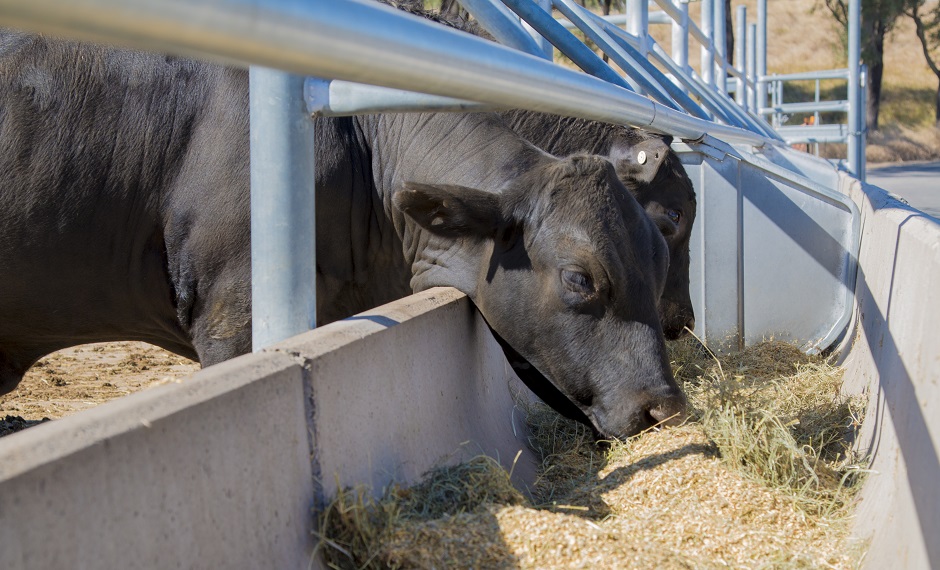
Cattle in a feed lot – an example of intensive farming.
When it comes to climate change, agriculture and the livestock industry often get a bad rap. Around 11.6 per cent of human-related greenhouse gas emissions come from farmed ruminants – animals such as cattle, sheep and goats.
While this has bad implications for climate change, it also presents opportunities to mitigate emissions and reduce livestock’s carbon footprint.
A new report led by the Food Climate Research Network at the University of Oxford, and involving our researchers and a number of international research institutes, studied the extent of emissions and various claims around reducing emissions.
Co-lead author and PhD Candidate Cécile Godde said the report focussed on the grass-fed beef industry and its impact on climate change.
“This report is about giving a balanced overview of the knowledge amassed on grazing systems, covering modelling as well as data from different grazing systems in real world trials,” said Ms Godde.
“We found that grazing systems are not a climate mitigation solution through their role in sequestering – or capturing – carbon in the soil, as some suggest. All livestock systems, including grazing systems are net emitters of greenhouse gases.”
What can we do about it?
The good news is that improvements can be made, with reductions of between 4 – 11 per cent of emissions in the livestock sector (or between 0.6 – 1.6 per cent of total annual greenhouse gas emissions) possible through the adoption of improved grazing management.
However, Ms Godde said there is an overlooked complexity to grazing systems that makes improvements very context specific.
“Worldwide, farmers are faced with different soil, climate, feed and livestock breed scenarios, which interact in complex ways,” she said.
“This means that a solution that works in one region won’t necessarily work in another, making this a significant policy area where governments at country and subnational levels need to work with their farmers.”
Separately to this report, technologies such as feed supplements and whole of landscape management practices also hold promise for changing the industry’s greenhouse gas footprint. We are also working on livestock efficiency, aiming to increase productivity from less feed intake, which would have a positive effect on methane emissions.
Challenges remain
The report also found that while it is possible to sequester carbon in the soil, this is only of time-limited benefit as soils reach carbon equilibrium within a few decades, and from that point onwards equal amounts of carbon flow out as they flow in.
Complicating matters is that carbon sinks are also reversible – what can be done, can be undone. Soil carbon stocks can increase through good soil management, but also be lost through bad management or climatic fluctuations such as a drought or fire.
Ruminants are also well known for expelling methane, which is a potent greenhouse gas around 30 times more harmful than CO2. Unlike CO2, methane is transient and disperses in the atmosphere. However, the report refutes claims that this means that methane is not a problem, showing that its greenhouse impacts continue as long as sources of methane (including the ruminant livestock sector) continue to exist. The report concludes that reducing the demand for livestock products is a viable approach to minimising greenhouse gas emissions.
“This report is about finding the least bad options for feeding the world in a sustainable way,” said Ms Godde.
A future report will study the relationship between livestock systems and biodiversity.


19th October 2017 at 11:47 am
@Steve Our research highlights that carbon sequestration potential at the global scale is far from outweighing the greenhouse gas emissions grazing systems currently emit. The downsizing of CH4 emissions for Australia was not taken into account in the studies we reviewed. Nonetheless, it’s safe to say that the main conclusion remains unchanged: in aggregate, grazing systems, as all livestock systems, are net emitters of greenhouse gases. Of interest, another study sponsored by NASA and published recently suggests that global methane emissions from livestock are larger than estimated when using the new emissions factors (https://www.ncbi.nlm.nih.gov/pubmed/28959823). They used 2014 National Inventory Submissions to the UNFCCC
17th October 2017 at 3:19 pm
Does this research take into account this earlier research by the CSIRO? http://www.csiro.au/en/News/News-releases/2015/Cattle-methane-emission-downsized
13th October 2017 at 6:15 pm
Great article summing up the FCRN work, and would only suggest an interesting additional note about methane. It is not so much that its difference from CO2 is down to what you call its dispersal, it is more that because of the combination of it being both more potent and also more short-lived compared to CO2 the end result is that over the next 20 years it is 100 times as harmful as CO2 and around a half of warming will be attributable to it. eg see Shindell 2012. http://www.igsd.org/documents/shindell1201138.pdf
12th October 2017 at 12:19 pm
https://www.linkedin.com/pulse/cattle-fattened-algae-barry-cohen/?trackingId=aJEcGwEHmbvxA4bRL7qc6Q%3D%3D
12th October 2017 at 8:25 am
This is an important, and as your report suggests ,complicated subject. We should take careful and well considered action. But how to get this action happening on the wider scale would seem problematic on its own. Best of luck with that.